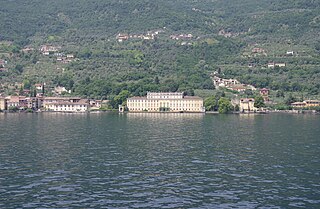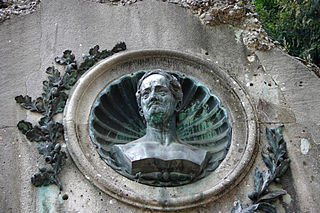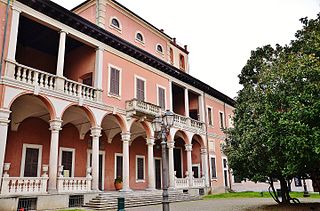
Ca' Rezzonico is a palazzo on the Grand Canal in the Dorsoduro sestiere of Venice, Italy. It is a particularly notable example of the 18th century Venetian baroque and rococo architecture and interior decoration, and displays paintings by the leading Venetian painters of the period, including Francesco Guardi and Giambattista Tiepolo. It is a public museum dedicated to 18th-century Venice and one of the 11 venues managed by the Fondazione Musei Civici di Venezia.

Andrea Appiani was an Italian neoclassical painter.

The Certosa di Pavia is a monastery and complex in Lombardy, Northern Italy, situated near a small town of the same name in the Province of Pavia, 8 km (5.0 mi) north of Pavia. Built in 1396–1495, it was once located on the border of a large hunting park belonging to the Visconti family of Milan, of which today only scattered parts remain. It is one of the largest monasteries in Italy.

Villa Pisani at Stra refers to the monumental, late-Baroque rural palace located along the Brenta Canal at Via Doge Pisani 7 near the town of Stra, on the mainland of the Veneto, northern Italy. This villa is one of the largest examples of Villa Veneta located in the Riviera del Brenta, the canal linking Venice to Padua. The patrician Pisani family of Venice commissioned a number of villas, also known as Villa Pisani across the Venetian mainland. The villa and gardens now operate as a national museum, and the site sponsors art exhibitions.

Giuseppe Zocchi was an Italian painter and printmaker active in Florence and best known for his vedute of the city.

The Villa Giovannelli Colonna is a rural palace located in Noventa Padovana, in the region of the Veneto near Padua, northern Italy, which once was famous for its splendid decorations.

The Villa Cicogna Mozzoni is a rural patrician residence in Bisuschio, near Varese, Province of Varese, region of Lombardy, Italy. It is an example of Lombard Renaissance architecture.

Santa Maria della Passione is a late Renaissance-style church located in Milan, Italy.

The art collections of Fondazione Cariplo are a gallery of artworks with a significant historical and artistic value owned by Fondazione Cariplo in Italy. It consists of 767 paintings, 116 sculptures, 51 objects and furnishings dating from the 1st century to the second half of the 20th century.

The Villa Sola-Busca, also called Villa La Quieta, is a Neoclassical style rural palace outside of the town of Tremezzo, on the shores of Lake Como in the Region of Lombardy, Italy.

Villa Bettoni is a large lake-side Neoclassical-style rural palace located in the frazione of Bogliaco, on the shores of Lake Garda, within the town limits of Gargnano, Province of Brescia, region of Lombardy, Italy. The massive villa and manicured gardens are a scenographic landmark on the Lake.
The Villa Litta Modignani is a 17th-century rural palace and park located on Via Taccioli in the north suburbs of Milan, in the Province of Milan, Lombardy, Italy.

The Casino Mediceo di San Marco is a late-Renaissance or Mannerist style palace located on Via Cavour number 57 and via San Gallo in Florence, region of Tuscany, Italy.
The Villa Sioli Legnani is a 19th-century rural palace located just outside the town of Bussero, Province of Milan, Lombardy, Italy.
The Villa Raimondi, also known over the centuries as Villa Tagliaferri or Isacco or Odescalchi, is a 19th-century rural palace located on Viale Raimondi #54, just outside the town of Fino Mornasco, Province of Como, Lombardy, Italy.

Villa Pallavicino delle Peschiere is a 16th-century villa in Genoa, Northwestern Italy, built in 1560 for the nobleman Tobia Pallavicino. It is situated in via San Bartolomeo degli Armeni 25, in the quarter of Castelletto, in an area that, at the time when the villa was built, was still outside of the city walls. After the urban expansion of the 19th century, it is now located in the center of the city. The villa still belongs to the Pallavicino family.

Villa Balbi Durazzo Gropallo "Dello Zerbino" is a 16th-century villa in Genoa, Italy. It is situated in the quarter of Castelletto, near Galeazzo Alessi's Villa delle Peschiere. It was constructed from 1599 to 1603 as a suburban villa for the Genoese noblemen Stefano Balbi, ambassador to Milan, and Giovanni Battista Balbi. The name Zerbino is derived from the Ligurian word zerbo, meaning "uncultivated"— at the time when the villa was built, the surrounding area was still outside of the city walls and uncultivated. In the 18th century it passed to Marcello III Durazzo, then to the Gropallo family. It is now owned by the Castelbarco Albani family and used as a venue for events and exhibitions.

Giuseppe Balzaretto or Balzaretti was an Italian landscape architect and architect.

The Mombello Psychiatric Hospital, also known as the "Giuseppe Antonini of Limbiate Psychiatric Hospital" , was the largest asylum in Italy, covering 40,000 m2 (430,000 sq ft) with multiple buildings located as to form a "small village". It is located in the Italian commune of Limbiate, in the administrative district of Monza and Brianza, Lombard Province. Officially inaugurated in 1878, it was the last psychiatric hospital to be closed after the approval of the Legge Basaglia in 1978.

The Villa Ghirlanda Silva is a 17th-century rural palace and park located in Cinisello Balsamo, just north of Milan, in the Province of Milan, Lombardy, Italy.



















